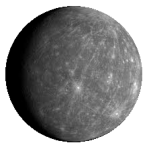It is difficult to observe surface features on Mercury from Earth. The planet is never more than 28 degrees
away from the Sun. That is what we call the maximum elongation of the planet. Some elongations are better
than others. If you are patient enough, it is possible to use CCD cameras to create images of Mercury even in
the daytime sky. Spacecraft have given us much more detailed images than we could possibly get from Earth. The
feature called Caloris , also seen here, faces the Sun on every second perihelion passage. The first close-up images of
Mercury were from the Mariner 10 spacecraft, which passed by the planet over thirty years ago. The Messenger
spacecraft was in orbit around Mercury for an extended mission, until it was deliberately crashed into the planet in early
2015. Data from MESSENGER revealed a feature called The Great Valley which is evidence that Mercury is shrinking
as it cools. This excellent video details the findings of this spacecraft. Most recently, the space probe has found
someone who is very hungry on the planet.
















































